Abstract
This paper presents a hybrid methodology for predicting rock mass deformation and roadway loads induced by longwall mining. The approach combines the classical Budryk–Knothe influence function model with numerical simulations in the FLAC3D finite difference environment. Instead of explicitly reproducing large-scale excavation and caving, the impact of mining is introduced through analytically derived displacement boundary conditions applied to the numerical model. This allows detailed analyses of the rock mass deformation state while significantly reducing computational effort compared with conventional geomechanical models. The methodology involves deriving displacement components from the Budryk–Knothe influence function, implementing them through Python 3.6.1 scripts in FLAC3D 7.00, and performing stepwise simulations of longwall advance. Results show that the proposed approach reduces the number of finite difference zones by nearly an order of magnitude, achieving more than a tenfold decrease in computation time. At the same time, the displacement and stress distributions obtained remain consistent with both the analytical Budryk–Knothe solution and those from the classical numerical model. The study demonstrates that this methodology provides a reliable and efficient tool for assessing stress redistribution and deformation around roadway excavations influenced by mining. Its application enhances the accuracy of deformation predictions, supports support system design, and improves safety and efficiency in underground mining operations.
1. Introduction
Forecasting the loads acting on mine workings during underground mineral extraction represents one of the fundamental challenges of contemporary rock mechanics. These loads exert a decisive influence on the stability of excavations, workplace safety, and the technical as well as economic efficiency of mining operations. An inadequate assessment of rock mass displacements may result in catastrophic consequences, including the destruction of workings or severe damage to mining infrastructure. Consequently, continuous efforts are directed toward the development of methods capable of accurately predicting the behavior of rock masses surrounding mine workings under varying geological and mining conditions.
The structure of the rock mass has been shaped over millions of years through the successive deposition of various lithological formations, resulting in a highly complex system. Consequently, the design of mine workings must account for a wide range of factors, encompassing both the natural conditions of the rock mass and the impacts of ongoing mining operations. One of the tools that enables the analysis of such complex issues is numerical modeling [1]. These models allow for a detailed examination of mine workings, taking into consideration aspects such as the type of support system, the staged excavation process, and the interaction between the support and the surrounding rock mass.
In numerical modeling of the rock mass, it is essential to incorporate a wide range of geological and geotechnical factors, such as stratification [2,3], the presence of discontinuities (e.g., faults), and the initial stress state [4]. A particularly challenging case in the analysis of roadway excavations is the influence of adjacent mining operations, which disturb the original stress distribution and may induce structural transformations within the rock mass. The stability assessment of such excavations becomes considerably more complex, requiring the inclusion of dynamic changes in the rock mass structure as well as in the associated stress–strain conditions.
This issue encompasses both existing excavations located in the vicinity of active mining operations and newly driven workings in rock masses already influenced by mining activity. Numerical modeling serves as an effective tool for reproducing stress–strain states under such conditions [1]. Utilizing numerical models, it is possible to simulate not only the mineral extraction process but also the behavior of roadway excavations. The achievable level of detail depends directly on the selected modeling approach, the specific objectives of the analysis, and the designer’s expertise and capabilities.
In rock mechanics, numerical methods based on continuum models, such as the finite element method (FEM) or the finite difference method (FDM), are commonly employed. Nevertheless, these methods have limitations that may prevent accurate reproduction of rock mass disintegration and the formation of caving zones, which are typical consequences of longwall mining with roof collapse. Longwall extraction in a continuum medium is often modeled by removing elements representing the extracted seam. However, this approach is only applicable in specific cases, for instance, for relatively small panels or in models where roof subsidence is less than the thickness of the mined seam [5,6]. An alternative approach involves introducing contact elements (interfaces) between the roof and floor [6,7], which prevents the unrealistic interpenetration of the roof and floor edges of the extracted seam that would not occur in the actual rock mass.
Another approach to modeling extraction in a continuum medium involves modifying the deformation parameters in the caving zone and in the fractured rock zone above the excavation [8,9]. This method enables the control of deformations through the appropriate selection of element parameters, thereby facilitating a realistic representation of the impact of mining on the rock mass.
An important aspect of such simulations is not only the one-time representation of caving but also the consideration of the advancing mining front [9]. This process is critical for capturing changes in stress distribution, the extent of damage zones, and overall rock mass deformation, all of which constitute essential components of the analyzed method.
Since the process of post-mining gob formation is associated with the destruction of rock mass continuity, methods based on discontinuous media models, specifically DEM and FDEM [1,10,11,12], are also utilized to simulate these phenomena. These models naturally reproduce the caving rubble in longwall mining or the Excavation Damaged Zone (EDZ) surrounding a roadway. The application of these solutions allows for the modeling of separate rock blocks, their displacement, rotation, and mutual interaction in a manner similar to the processes genuinely occurring in a rock mass subjected to mining activity. These deformations arise automatically during the simulation process and, in contrast to FEM, do not require adopting additional assumptions concerning constitutive models, rock parameters, or the extent of the caving or EDZs. This inherent capability constitutes a very important advantage of DEM-based methods.
Each modeling method has its own advantages and disadvantages, which are comprehensively discussed in various works [1,10]. Although this paper focuses on the continuum model using the FDM, the proposed hybrid solution can also be applied, with appropriate modifications, to simulations based on discontinuous media models.
2. Materials and Methods
2.1. Limitations of the Classical Approach to Numerical Modeling of Large-Scale Rock Mass Deformations
Properly conducted numerical simulations serve as a valuable tool for the design of new mine workings and for assessing the stability of existing structures. However, mine workings are often subjected to the influence of deeper mining operations, which induce rock mass deformations, redistribution of the initial stress state, and changes in the rock structure. These changes include the formation of caving zones in the immediate vicinity and fractured zones at greater distances from the mined-out area.
Many authors have addressed these issues by utilizing numerical models that incorporate both the specific excavated workings under consideration and the large volume of surrounding rock mass affected by the mining activity [3,5,6,13].
This approach has the following requirements:
- It requires the construction of a “large” numerical model encompassing not only the area of the roadway excavation under analysis but also extensive volumes of the surrounding rock mass representing the region of the mined coal seam. Increasing the model dimensions necessitates a corresponding increase in the number of discretizing elements, which prolongs the computational procedure and makes it more resource-intensive.
- Regarding model size, it is also important to note that accurately reproducing stress–strain states in the vicinity of a roadway excavation requires precise modeling of its geometry, the lithological structure of the surrounding rock mass, and the support elements. These elements are relatively small in scale; for example, the thickness of shotcrete lining is 0.2 m, the cross-sectional area of a commonly used V32 steel support profile in Polish mining is only 40.8 cm2, and the average diameter of rock bolts is approximately 2 cm. Natural factors, such as layer thicknesses, may also be measured in centimeters. These dimensions are negligible compared to the extents of mining panels, where the average longwall length is 200 m and the longwall advance often exceeds 1 km.
- Modeling extraction impact should account for the staged nature of seam exploitation. One of the most common underground mining systems for sedimentary deposits is the longwall system, in which coal is cut by a longwall shearer moving along the face and extracting the seam to an average depth of 0.8–1.0 m. In a numerical model, ideally, this advancement should be reproduced—see Figure 1.
 Figure 1. Example of a model with (a) staged simulation of extraction, (b) and simultaneous removal of elements along the entire longwall advance of the modeled panel.
Figure 1. Example of a model with (a) staged simulation of extraction, (b) and simultaneous removal of elements along the entire longwall advance of the modeled panel.
Achieving this requires a discretization of the model that allows for such staged progression, meaning that the dimensions of individual model elements should not exceed 1 m. Under this assumption, and considering a longwall advance of 1 km, very large-scale numerical models must be employed. Their use is inefficient and involves multi-stage simulations of highly complex models to reproduce the state of the rock mass in the vicinity of a roadway excavation, which is considerably smaller in scale.
- Modeling of mechanized longwall support. Another challenge in attempts to numerically simulate coal extraction using the longwall system is the incorporation of mechanized support within the modeled longwall panel. This issue can be addressed in several ways:
- ○
- Modeling the longwall support using structural elements, i.e., beam or shell elements, with parameters chosen to replicate the stiffness and flexibility of the mechanized support [8,14,15,16].
- ○
- Modeling the support as a distinct region within the model, assigned appropriate strength parameters and constructed, depending on the problem, from either three-dimensional or two-dimensional discretization elements corresponding to the employed numerical method [17,18,19].
- ○
- Representing the action of the support on the roof and floor of the longwall excavation by introducing additional forces into the model to reproduce the support’s resistance [13,20].
Support is considered in analyses of stress–strain states in the immediate vicinity of the longwall excavation. However, in most numerical simulations of coal seam extraction, the longwall support is typically omitted [7,9,21,22,23].
- Modeling of caving zones. The mechanical behavior of the rock mass, especially the creation of post-mining gob (caving), is inherently associated with the disruption of rock mass continuity. To simulate such phenomena with high fidelity, methods based on discontinuous media models, such as the Discrete Element Method (DEM) or the Finite Discrete Element Method (FDEM), are ideally suited. The primary advantage of these discontinuous methods is their ability to naturally simulate the mechanisms of failure and large deformation. They allow for the modeling of separate rock blocks, their displacement, rotation, and mutual interaction in a manner that closely resembles the processes occurring in the roof of the mined seam [24,25]. This capability naturally reproduces the caving rubble and the Excavation Damaged Zone (EDZ) surrounding a roadway, as demonstrated in numerous detailed studies [26,27,28]. However, even with discontinuous approaches, fully reproducing the caving process remains a persistent challenge [15,22,26,27]. In the case of continuum models—such as the Finite Difference Method (FDM) utilized in this work—the creation of the gob must be approximated. This is typically represented by filling the caving zone with a substitute material having appropriately chosen parameters to reflect the properties of the rubble [9,20,22], or by removing the seam elements and inserting contact elements to transfer forces between the roof and floor [23,29,30]. The use of such models allows for an approximate representation of stress–strain states in the rock mass, although the final behavior of the model is highly dependent on the parameters assigned to the substitute material.
- The use of a two-dimensional model involves simulations in which the longwall panel is treated as having infinite length (i.e., the third dimension is neglected). In many cases, two-dimensional models are used for simulating mining operations [6,15,31]. Omitting the third dimension is justified when the problem has a single direction along which the geometry and boundary conditions remain constant, which can be reasonable for roadway excavations. However, in the case of longwall coal extraction, adopting a two-dimensional model requires if one of the characteristic dimensions of the mining panel (either the panel length or the longwall advance) is infinite. This assumption can result in significantly more intense deformations and stress concentrations than occur, where the mining panel has finite dimensions. This limitation is particularly important for roadway excavations located at greater distances from the extracted seam.
2.2. General Characteristics of the Proposed Methodology for Predicting Rock Mass Deformation
Considering the limitations of the previously discussed approaches, this study proposes the application of a hybrid modeling method for analyzing phenomena that occur in the vicinity of roadway excavations affected by mining operations.
The principal assumption of the proposed methodology is to reproduce the rock mass deformation state surrounding the excavation within a numerical model developed in FLAC3D by introducing analytically determined displacement boundary conditions. It is assumed that displacements along the model boundaries are defined using the Budryk–Knothe theory [32,33,34], which is based on the concept of the “influence function”. The integration of this function over the area of the mined panel allows for the determination of deformation indices, including displacements in arbitrarily defined directions:
where
x,y: Independent space variables,
p,q: Coordinates of the given calculation point
z: Height over the extracted seam
H: Extraction depth calculated from surface
P: Extracted area.
In Budryk–Knothe’s model, the influence function in 2D coordinates takes the following form:
where
- wmax:
- Maximum possible subsidence at the land surface level that may occur after extracting a deposit layer of thickness g,
- :
- Parameter characterizing the dispersion (or “range”) of extraction influences named the radius of major influences dispersion (or “range”). It may be calculated from the formula (Figure 2): , where β is the “angle of major influences dispersion”.
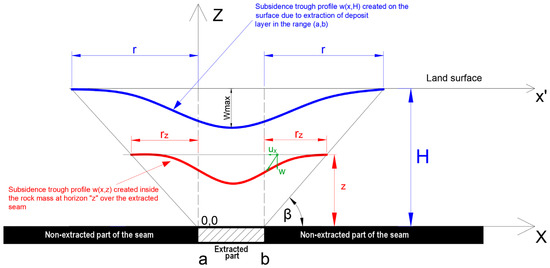 Figure 2. The exemplary profile of subsidence troughs on the surface and inside the rock mass resulting from the extraction of deposit layer in the range (a,b).
Figure 2. The exemplary profile of subsidence troughs on the surface and inside the rock mass resulting from the extraction of deposit layer in the range (a,b).
For the case of a mined-out panel represented by an infinite strip of width (a–b), as shown in Figure 2, the vertical displacements (subsidence) can be expressed as follows:
The horizontal displacements in the x-direction are given by:
where B denotes the parameter defining the magnitude of horizontal displacements.
This analytical model has been successfully applied as an independent predictive tool, often with certain modifications, in many countries to predict deformation state of both the rock mass and the ground surface [35,36,37,38,39]. The advantages of this approach lie in its simplicity and in the well-established knowledge of the parameter values required for reliable predictions. Moreover, its long-term application over several decades has enabled extensive verification against measurements conducted both within the rock mass and at the surface.
Referring to the aforementioned challenges associated with modeling roadway excavations subjected to mining influences, the proposed method enables:
- Detailed modeling of the excavation, accurate reproduction of its geometry using sufficiently dense discretization, and consideration of its support system, without the need to include large volumes of the rock mass affected by mining operations in the model (Figure 3).
 Figure 3. Dimensions of the numerical model for the classical approach (blue color) and for the proposed methodology (magenta color).
Figure 3. Dimensions of the numerical model for the classical approach (blue color) and for the proposed methodology (magenta color). - A significant acceleration of computations, due to the elimination of the need to simulate complex deformation processes of large rock mass volumes and their structural changes upon reaching limit states.
- The ability to perform simulations without numerically modeling the complex processes of coal extraction and caving rubble formation.
- The incorporation of rock mass deformations calculated using the widely applied and recognized Budryk–Knothe method.
- The ability to perform calculations for any location of the mining panel relative to the modeled rock mass. It should be noted, however, that an excavation located outside the main influence zones will not generate any interaction.
- An arbitrarily small step of longwall face advance. As mentioned earlier, the minimum advance should depend on the cutting depth of the shearer, yet in the proposed method the extent of the extracted seam in successive simulation stages can be chosen freely.
- Modeling the impact of multi-seam, multi-stage mining on the excavation with any number of longwalls.
- Modeling the effects of mining with roof caving, as well as with backfilling.
2.3. Detailed Algorithm of the Applied Solution
The entire presented solution pertains to numerical simulations conducted using the FLAC3D program, which is based on the finite difference method. One of the advantages of this tool is the ability to construct and control the simulation model using the Python 3.6.1 programming language. The applied methodology encompasses the following stages for model construction, followed by the simulation of mining impacts, and is carried out in the following steps (see also Figure 4):
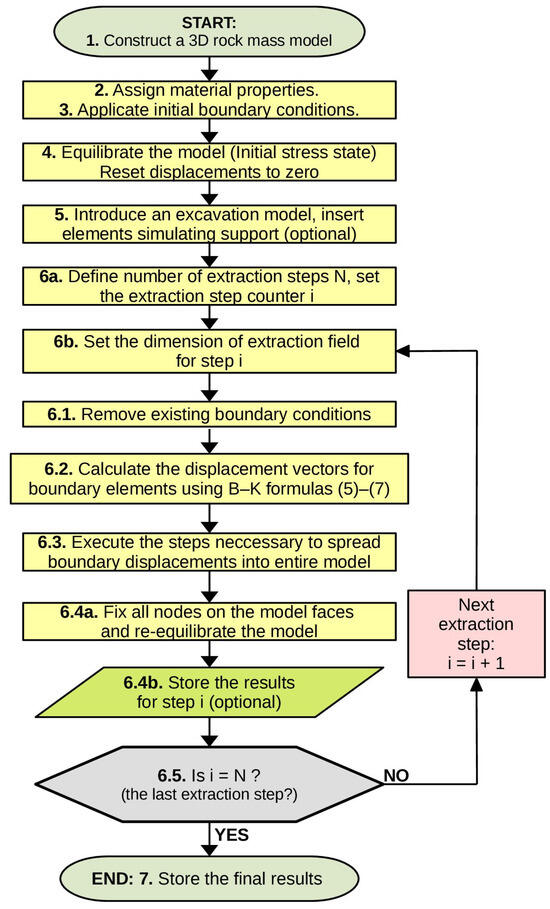
Figure 4.
Flowchart of the algorithm integrating FLAC3D with the proposed hybrid methodology.
- Construction of a three-dimensional numerical model of the rock mass, including the roadway excavation.
- Assignment of rock mass material parameters.
- Application of boundary conditions by fixing nodes located on the external faces of the model.
- Equilibration of the model in the initial state and resetting of displacements to zero.
- Modeling the excavation by removing the elements within its outline. Introduction of elements representing the action of the support system. Depending on the requirements, the support can be incorporated at different stages of excavation relaxation. For more detailed simulations, the excavation process can be modeled as a multi-stage operation. Equilibration of the model after the excavation allows obtaining the state of the rock mass in its vicinity without the influence of mining activities.
- Simulation of mining impacts on the analyzed excavation. Definition of the extent of the simulated extraction by specifying its geometry and the number of stages, as required by the user, into which the entire mining panel will be divided. Implementation of the Budryk–Knothe model parameters. Calculations are performed in a loop for each of the defined extraction stages:
- 6.1.
- Removal of existing boundary conditions in the model.
- 6.2.
- Calculation and application of boundary conditions in the form of displacement velocities expressed in units of length per iteration. For each node located on the external faces of the model, a specific displacement velocity is determined based on its location relative to the area being extracted in the current simulation stage. The prescribed displacement velocity is derived from the displacements calculated using the Budryk–Knothe method, divided by the number of steps required for stable deformation of the model (Figure 5).
 Figure 5. Diagram of analytically defined changes in boundary conditions representing the rock mass state depending on the location relative to the extracted seam.
Figure 5. Diagram of analytically defined changes in boundary conditions representing the rock mass state depending on the location relative to the extracted seam. - 6.3.
- Execution of the specified number of iterations to achieve the displacements of the entire numerical model caused by the extraction of the partial seam.
- 6.4.
- Removal of the boundary conditions representing mining impacts, fixation of all nodes located on the model faces, and re-equilibration of the model.
- 6.5.
- If the simulated extraction has been completed, the calculations end; otherwise, return to step 6.1.
To calculate the displacement velocities defined in step 6.2 of the algorithm, it was necessary to develop relationships allowing the determination of displacements induced by the extraction of a given portion of the mining panel. For the purposes of this study, appropriate formulas were derived, enabling rapid and efficient calculation of the displacement components of a point within the rock mass according to the Budryk–Knothe model. These formulas are valid for the extraction of a panel shaped as a rectangle with dimensions [(a–b) × (c–d)], as illustrated in Figure 6. The relationships are as follows:
Vertical displacement component (subsidence):
Horizontal displacement component in the x-direction:
Horizontal displacement component in the y-direction:
where
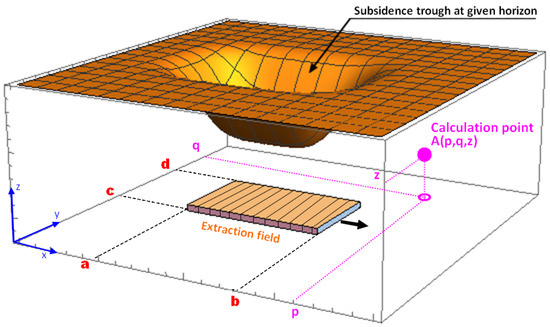
Figure 6.
Computational diagram for Formulas (5)–(7).
3. Results and Discussion
3.1. Results of Simulations
This section presents the results of numerical simulations conducted on both a classically constructed model and a model with boundary conditions simulating the impact of coal seam extraction using Budryk–Knothe model. The same assumptions regarding the simulated coal extraction were adopted in both models, namely:
- Thickness of the extracted seam: 4.0 m.
- Length of the longwall panel: 200 m.
- Longwall advance: 200 m.
- Simulation conducted in 20 stages, each corresponding to the extraction of a strip measuring 10 × 200 m.
- For the rock mass, an elasto-plastic model with Coulomb–Mohr strength criterion was applied, with the following parameters: bulk modulus = 66.7 MPa, shear modulus = 40.0 MPa, cohesion = 5 MPa, friction angle = 45°, density = 2500 kg/m3.
In the case of the classical approach, the model represented a rectangular prism of rock mass with dimensions of 400 × 400 × 200 m (Figure 7), discretized into 3,635,758 finite difference zones connected at 615,467 nodes. This model is hereinafter referred to as Model A.
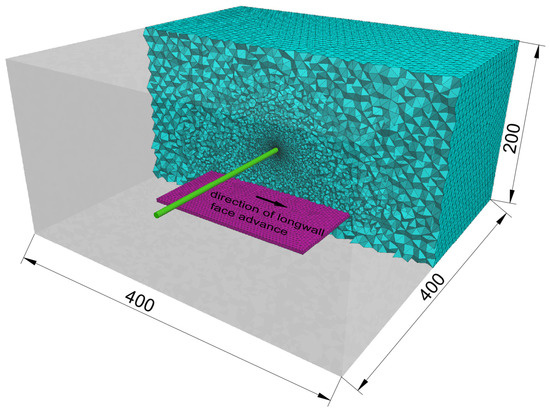
Figure 7.
Computational Model A used for simulations.
Boundary conditions were applied to fix the lateral and bottom faces of the model. A vertical stress of −17.125 MPa was applied to the top face, corresponding to its location at a depth of 685 m.
In this case, the extraction was modeled by sequentially removing the elements composing the model; in each stage, the elements contained within a prism measuring 10 m along the longwall advance, 200 m along its full length, and 4 m in thickness of the extracted seam, were removed. The removal of elements from the model interior creates a void between the roof and floor of the extracted seam, toward which the modeled rock mass deforms. To prevent interpenetration of the roof and floor, interface elements were introduced into the model at each stage of the extraction.
The same mining–geological conditions were also reproduced in a model with boundary conditions defined using the Budryk–Knothe analytical approach (hereinafter referred to as Model B), simulating extraction with parameters identical to those previously described for Model A. This model had dimensions of 40 × 40 × 40 m (Figure 8) and was composed of 306,558 finite difference zones connected at 53,269 nodes.
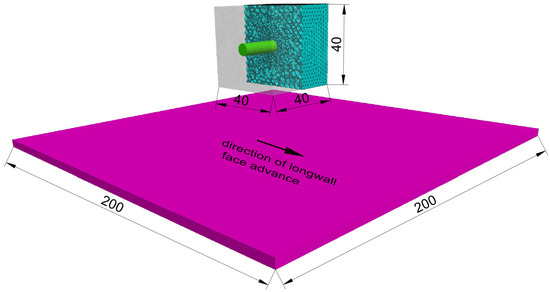
Figure 8.
Computational Model B used for simulations.
In both cases, the simulations were conducted in 20 stages, representing the progress of the extraction front. For comparison purposes, results are presented in Figure 9 for three extraction stages, corresponding to the longwall face located at 80, 100, and 120 m of advance.
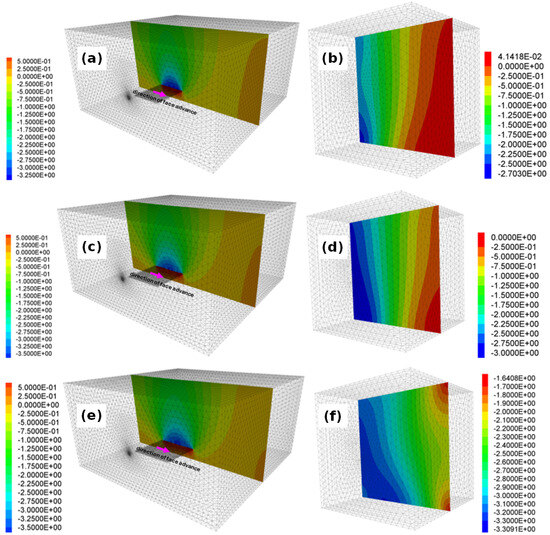
Figure 9.
Distributions of vertical displacements: (a) Model A, longwall advance 80 m; (b) Model B, longwall advance 80 m; (c) Model A, longwall advance 100 m; (d) Model B, longwall advance 100 m; (e) Model A, longwall advance 120 m; (f) Model B, longwall advance 120 m.
A preliminary comparison of the results obtained for both models indicates substantial differences; however, these discrepancies are primarily attributable to the disparity in their volumes. Model A (Figure 9a,c,e) represents the rock mass together with the extracted seam. The maximum absolute vertical displacements occur in the roof of the extracted seam, reaching up to 3.5 m.
3.2. Methodology of Performance Tests
To evaluate the quality and reliability of Models A and B, a reference Model C was prepared. In this model, displacements throughout the entire volume of the simulated rock mass were calculated analytically using the DEFK-Win software (version 5.8) [40,41], whose computational algorithm is based on the Budryk–Knothe model. Due to its decades-long practical application in predicting subsidence and surface deformations, the Budryk–Knothe approach may serve as a reliable benchmark for comparison.
For a reliable assessment, a specific extraction stage was selected in which the extraction edge was positioned precisely at the center of the modeled area (half the total longwall advance: 100 m). The analysis was conducted on datasets comprising vertical displacement values across the model cross-section, with 19 horizontal levels ranging from a minimum Z-level of 30 m above the roof of the extracted seam to a maximum Z-level of 66 m (see Figure 10).
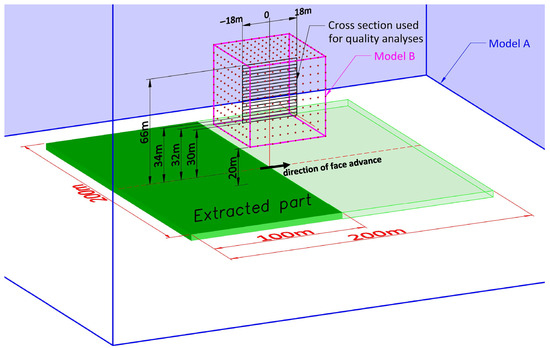
Figure 10.
Location of the analyzed cross-section relative to the extraction stage—at half the total longwall advance (100 m from the starting edge).
Each dataset (Models: A, B, and C) contained 50 data points along a horizontal line for each of the 19 Z-levels, resulting in a total of 950 measurement points for the global analysis after merging. A filtering threshold of 1 × 10−4 m was applied to exclude negligible displacements, ensuring that both statistical and visual analyses focused on significant deformations.
The analyses were conducted in two directions:
- (a)
- Comparison of the quality of Models A and B relative to the reference Model C (Section 3.3).
- (b)
- Comparison of the computational time required to complete full simulation cycles in Models A and B (Section 3.4).
3.3. Assessment of Models’ Quality
3.3.1. Quality Assessment Procedure
The comparative assessment involved:
- Statistical metrics:
- ○
- Pearson’s Correlation Coefficient (R) and Spearman’s Rank Correlation Coefficient (Rho) to assess linear and monotonic relationships, respectively.
- ○
- Mean Squared Error (MSE), Root Mean Squared Error (RMSE) and Mean Absolute Error (MAE) were used to quantify prediction errors.
- ○
- The Coefficient of Determination (R2) provided insight into the proportion of variance in the reference model explained by the predictive models.
- These metrics were calculated both for individual Z-levels and globally across the entire dataset. Results for individual Z-levels are shown in Table 1 while global metrics are presented in Table 2.
 Table 1. Measures of convergence/similarity computed for each individual Z-level.
Table 1. Measures of convergence/similarity computed for each individual Z-level. Table 2. Global convergence/similarity measures calculated from aggregated datasets.
Table 2. Global convergence/similarity measures calculated from aggregated datasets.
- Analysis of differences:
- ○
- The analysis of differences (Model–Reference) provides crucial insights into systematic biases. The following measures were calculated: mean difference, median difference, standard deviation of differences, min and max difference. They were calculated for individual Z-levels and globally across the entire dataset. Results for individual Z-levels are shown in Table 3 while global metrics are presented in Table 4.
 Table 3. The results of the analysis of differences across individual Z-levels.
Table 3. The results of the analysis of differences across individual Z-levels. Table 4. The results of global analysis of differences performed based on aggregated sets.
Table 4. The results of global analysis of differences performed based on aggregated sets.
- Visualizations:
- ○
- Cross-section Plots: Displaying vertical displacements along the profile for all Z-levels for direct comparison between the models A, B and the reference model C (Figure 11).
 Figure 11. Vertical displacement profiles around extraction edge at individual horizons determined using the classical approach (Model A: top), the proposed methodology (Model B: middle), and the reference model (Model C: bottom).
Figure 11. Vertical displacement profiles around extraction edge at individual horizons determined using the classical approach (Model A: top), the proposed methodology (Model B: middle), and the reference model (Model C: bottom). - ○
- Scatter Plots: Illustrating the correlation between predicted and reference displacements, with a line of perfect agreement (y = x) for visual assessment of bias and scatter (Figure 12).
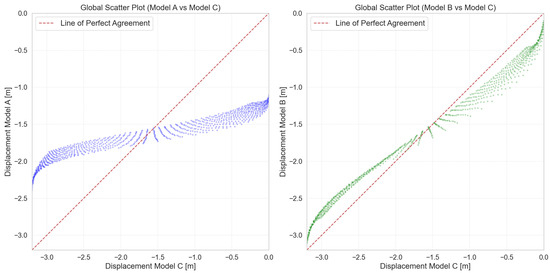 Figure 12. Correlation plots between the analyzed Models A and B and the reference Model C.
Figure 12. Correlation plots between the analyzed Models A and B and the reference Model C. - ○
- Histograms of Differences: Showing the distribution of discrepancies between the models and the reference, indicating the magnitude and frequency of errors (Figure 13).
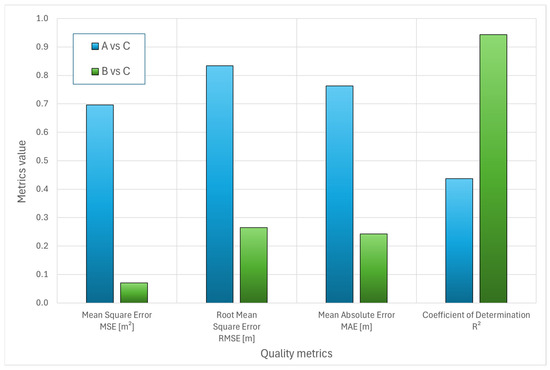 Figure 13. Comparison of the quality metrics of Models A and B relative to reference Model C, determined globally across the entire sets of results from both models.
Figure 13. Comparison of the quality metrics of Models A and B relative to reference Model C, determined globally across the entire sets of results from both models. - ○
- Difference maps: Providing a spatial overview of displacement differences across the entire Z-level and distance grid (Figure 14).
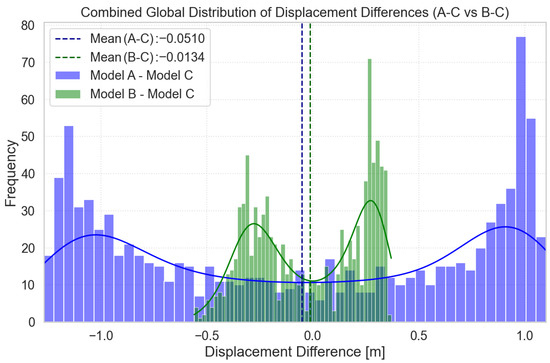 Figure 14. Histograms of differences between the analyzed Models A and B and the reference Model C.
Figure 14. Histograms of differences between the analyzed Models A and B and the reference Model C. - ○
- Global convergence/similarity measures: Figure 15, showing the graphical presentation of the results presented in Table 2.
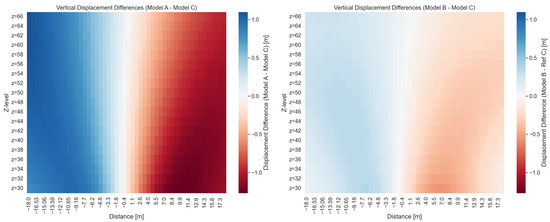 Figure 15. Spatial distributions of differences between the analyzed Models A and B and the reference Model C.
Figure 15. Spatial distributions of differences between the analyzed Models A and B and the reference Model C.
3.3.2. Discussion on Model’s Quality Performance
Level-Wise Performance and Trends
The error metrics for Model A presented in Table 1 are substantially higher than those for Model B across all Z-levels. For example, at z = 66 m, Model A’s RMSE is 0.7063 m, rising to 0.9503 m at z = 30 m. The R2 values for Model A are significantly lower, ranging from around 0.389 at z = 66 m to 0.483 at z = 30 m. This indicates that while Model A captures the general monotonic trend, its quantitative accuracy is considerably poorer.
The error metrics (MSE, RMSE, MAE) for Model B generally show a slight increase with decreasing Z-level but remain relatively low. For instance, at z = 66 m, Model B’s RMSE is 0.1928 m, increasing to 0.3267 m at z = 30 m. The R2 values for Model B remain high, typically above 0.93, across all levels.
The above-mentioned facts find confirmation in Figure 11, where profiles of vertical displacement lines for Model B are close to the picture of reference Model C displacements. Model A here presents distribution of vertical displacement very close to straight line with inclination suggesting massive influence range as determined in the relation to edge of extraction (x coordinate = 0). Such situation is far from practical findings, where spread of influences is limited to certain distance from the edge.
Global Performance Evaluation
The global statistical analysis reveals a clear distinction in performance between Model A and Model B when compared to reference Model C. Details are shown in Table 2.
Globally, Model B demonstrates substantially higher correlation coefficients (Pearson R = 0.9948, Spearman Rho = 0.9976) with reference Model C, indicating a very strong linear and monotonic relationship. Conversely, Model A exhibits notably lower correlation values (Pearson R = 0.9631, Spearman Rho = 0.9811). In terms of error metrics, Model B consistently outperforms Model A. Model B’s MSE (7.0266 × 10−2 m2), RMSE (0.2651 m), and MAE (0.2430 m) are significantly lower than those of Model A (MSE = 6.9631 × 10−1 m2, RMSE = 0.8345 m, MAE = 0.7633 m). This indicates that Model B’s predictions are considerably more accurate and precise compared to Model A.
Furthermore, Model B’s R2 value of 0.9432 signifies that approximately 94.32% of the variance in the reference model’s displacements can be explained by Model B. In stark contrast, Model A’s R2 of 0.4374 suggests that it explains only about 43.74% of the variance, highlighting its limited predictive power relative to Model C.
The visual representation of the data provides further confirmation of these findings. The scatter plot presented in Figure 12 clearly shows that, relative to Model A, Model B exhibits significantly less dispersion of data points around the line of perfect agreement. A similar trend is observed in Figure 13, where selected quality metrics (derived from Table 2) demonstrate a substantially better consistency for Model B.
Analysis of Differences
As can be seen from Table 3, for Model A, the mean difference per Z-level shows a more pronounced negative trend with depth, ranging from 0.0468 m at z = 66 m to −0.1448 m at z = 30 m. More critically, the standard deviation of differences for Model A is significantly larger, ranging from approximately 0.71 m to 0.95 m. This indicates a higher degree of scatter and larger, more inconsistent errors compared to Model B, suggesting a less reliable prediction.
For Model B, the mean difference per Z-level is generally close to zero, ranging from 0.0320 m at z = 66 m to −0.0774 m at z = 30 m. The standard deviation of differences for Model B is relatively small, ranging from approximately 0.19 m to 0.32 m. This suggests that Model B’s discrepancies are largely random and centered around zero, indicating minimal systematic overestimation or underestimation.
Global analysis of the differences, as presented in Table 4, reveals significantly lower error metrics for Model B. Specifically, the mean of the differences is approximately halved, and the standard deviation of the differences is reduced by a factor of three compared to Model A’s metrics. This decisively confirms better performance of Model B from a predictive accuracy standpoint.
The visual representation of the data in the form of histograms, as shown in Figure 14, confirms that the dispersion of differences for the (Model B–Model C) comparison is definitely narrower around the mean value compared to that of (Model A–Model C). Furthermore, the spatial distribution of differences across the considered cross-section plane (see Figure 10), which is presented in Figure 15, globally validates the lower differences exhibited by Model B relative to the reference model. This is visually evidenced by the less intensive colors, closer to white, which indicate a difference distribution approaching zero.
3.4. Analysis of the Computational Performance of the Proposed Method
To compare the computational performance of the proposed method with the classical approach, the computation times required for three types of constitutive models were compiled: an elastic model (model E), an elasto-plastic model (model CM), and an elasto-plastic model with softening (model SS).
The calculations were performed on a computer equipped with an AMD Ryzen Threadripper 3970X processor with 32 cores and 64 threads, operating at a clock frequency of 4.5 GHz. The comparison was carried out using the models presented in Section 4—models A and B. To render the simulations more realistic, a circular cross-section roadway excavation was included in the models.
The time required to equilibrate the model depends, among other factors, on the density of its discretization, i.e., the number of finite difference zones composing it. For the models presented in this study, in the case of the classical approach (Model A), the rock mass volume with dimensions of 400 × 400 × 200 m (Figure 7) was discretized using 3,083,901 tetrahedral finite difference zones, whereas the Model B based on the proposed method, had dimensions of 40 × 40 × 40 m (Figure 8) and was constructed from 306,558 finite difference zones. The nearly tenfold difference in the number of zones already indicates a substantially higher computational efficiency.
In addition to discretization density, the choice of constitutive model also affects computation time, as shown in Table 5. For both the elastic and elasto-plastic models, computation times are more than ten times shorter for Model B. This difference becomes even more pronounced when an elasto-plastic model with shear softening (SS) is used.

Table 5.
Comparison of simulation durations for the considered constitutive models.
These results clearly indicate that the use of a model with appropriately defined boundary conditions allows for a reduction in the time required to perform simulations, which is particularly important in multi-scenario analyses where computation times can be several times longer.
4. Comparison of Models A and B for the Case of Rock Mass Modeling with an Excavated Roadway
The proposed method for simulating the effects of mining on the rock mass state can be applied to the analysis of stress–strain conditions in the vicinity of roadway excavations located in rock mass already affected by mining operations, or in excavations that may be subjected to such influences in the future. In this context, it is crucial to determine the stress state of the rock mass surrounding the excavation, based on which, by comparing with the strength parameters of the rocks, one can infer the static load on the support system as well as the magnitudes and directions of deformations of the excavation’s cross-section. The following Figure 16 and Figure 17 present the distributions of the minimum principal stresses in models A and B with a circular cross-section roadway modeled. According to the convention adopted in FLAC3D, compressive stresses are assigned negative values, and the minimum principal stresses indicate the magnitudes of the maximum compressive stresses. The results for both models are presented for the following simulation stages:
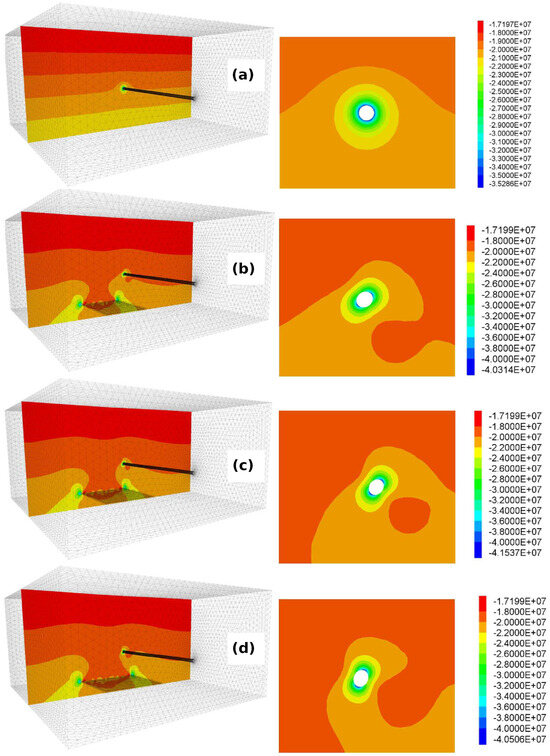
Figure 16.
Distributions of minimum principal stresses calculated with assumptions of Model A (values in Pascals) in the cross-section of the rock mass model with a roadway excavation and simulated mining: (a) without mining influence, (b) longwall face 20 m before the excavation, (c) longwall face directly beneath the excavation, (d) longwall face 20 m beyond the excavation.
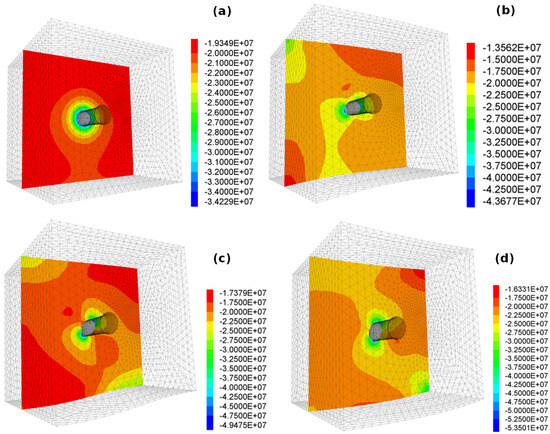
Figure 17.
Distributions of minimum principal stresses calculated with assumptions of Model B (values in Pascals) in the cross-section of the rock mass model with a roadway excavation: (a) without mining influence, (b) longwall face 20 m before the excavation, (c) longwall face directly beneath the excavation, (d) longwall face 20 m beyond the excavation.
The distribution of minimum principal stresses in Model A (classical approach), following the execution of the roadway excavation but before the influence of mining, is presented in Figure 16a. In this baseline case, the stress distribution exhibits circular symmetry, reaching a maximum value of approximately 35.3 MPa along the excavation boundaries. At greater distances, the stresses approach the value of the original, in situ stress state. In subsequent simulation stages, corresponding to different advances of the longwall face, the locations of maximum compressive stresses shift due to the modeled coal seam exploitation. Two symmetrical stress concentration zones are generated at the roadway boundaries, where the minimum principal stresses reach nearly 41 MPa. Such high stress concentrations in a real roadway could lead to a significant increase in the excavation damage zone and impose substantial additional loading on its support. As the simulation progresses, these stress concentrations shift from the excavation sides (Figure 16b) to points in the roof and floor of the excavation (Figure 16d). This dynamic change results in shifts in the directions and magnitudes of the loads acting on the roadway support.
A similar pattern of stress–strain changes (Figure 17) is observed in simulations conducted using Model B (hybrid approach). Compared to the classical approach, these hybrid calculations are significantly less time-consuming and avoid the numerous practical drawbacks discussed in Section 2.1. The results for Model B presented in Figure 17a indicate that, similarly to Model A, maximum compressive stresses are distributed uniformly along the excavation perimeter (34 MPa) in the absence of an advancing extraction front and assuming a hydrostatic stress state. These stresses gradually approach the initial values (19.3 MPa) with increasing distance from the boundaries. As the longwall face approaches the center of the excavation, the maximum compressive stresses increase, and their locations shift in the surrounding area, mirroring the behavior observed in Model A. When the face is positioned 20 m before the excavation center, elevated compressive stresses of up to 43 MPa are observed, primarily along the excavation sides (Figure 17b). In subsequent stages, the stress concentrations become even higher; when the longwall face is directly beneath the excavation, the stress reaches 49 MPa (Figure 17c). The concentration reaches its peak value of 53 MPa after the extraction front moves 20 m beyond the roadway center (Figure 17d). In the following stages, the compressive stress concentrations gradually dissipate, such that by the final simulation stage, the distribution of minimum principal stresses closely resembles the initial state.
The distributions of minimum principal stresses presented above (Figure 16 and Figure 17) are significant primarily for comparing the classical model with the hybrid model proposed in this paper. However, for mining practice, the most crucial factors are the displacements that the roadway may undergo due to mining influence, and how the rock mass structure will change under these conditions—specifically, the shape and extent of the Excavation Damaged Zone (EDZ). This information is vital, primarily for the design of support systems for such excavations. The predicted range of deformations allows for the appropriate selection of yielding support, while the results describing the EDZ enable inferences regarding the static load imposed on the support and the required lengths and bearing capacities of rock bolts.
The results presented below illustrate the vertical displacements in a cross-section through the model where the boundary conditions replicate the influence of longwall mining. The assumptions regarding the mining operation and the model construction are the same as those for the model whose results are shown in Figure 9.
Upon the excavation of the roadway, and in the absence of mining influence (Figure 18a), its contours experience displacements directed towards the excavation void. The magnitude of these displacements depends on a range of factors, such as the mechanical properties of the rock mass, the extent of the EDZ, the initial stress state, the type of support, the excavation technology, and the cross-sectional dimensions of the roadway, among others. All these factors can be accounted for in the numerical model. In the example model, the maximum vertical displacements occur in the roof and floor of the simulated excavation, reaching approximately 0.5 m. These deformations are localized only in the immediate vicinity of the excavation and dissipate with increasing distance from its contours.
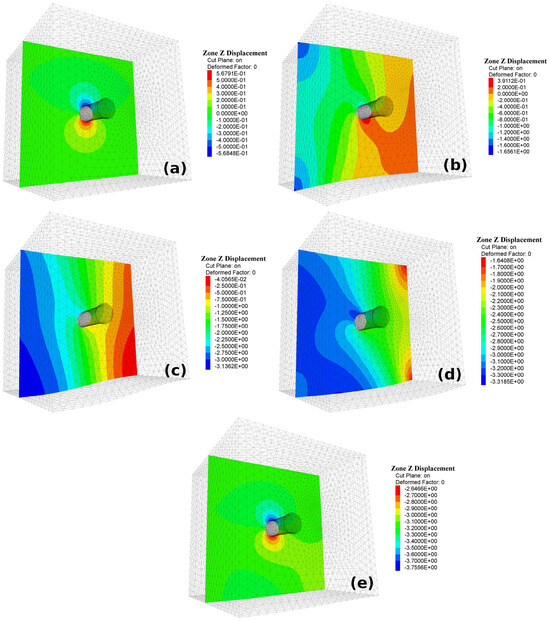
Figure 18.
Distributions of vertical displacement calculated with assumptions of Model B (values in meters) in the cross-section of the rock mass model with a roadway excavation: (a) without mining influence, (b) longwall face 20 m before the excavation, (c) longwall face directly beneath the excavation, (d) longwall face 20 m beyond the excavation (e) longwall face 100 m beyond the excavation.
As the longwall face approaches, the simulated rock mass experiences displacements directed towards the excavation void. Figure 18b presents the vertical displacements for the case where the longwall face is located 20 m ahead of the roadway symmetry axis. At this stage, a significant increase in vertical displacements is visible, with maximum values occurring at the model’s left boundary. The vertical displacement of the left boundary is approximately 1.6 m, which is consistent with the Budryk–Knothe model’s assumption that vertical displacements above the extraction front equal half of the maximum displacements for a full subsidence trough. The vertical displacements of the roadway roof reach close to 1 m, and the roadway’s cross-section begins to deform asymmetrically–with particularly large displacements occurring in the ribside adjacent to the approaching longwall face.
After the longwall face moves beneath the roadway axis (Figure 18c), the vertical displacements throughout the entire model exhibit only negative values, and the roadway is located within the subsidence zone amounting to approximately 1.6 m. The differences in displacements at the roadway contours between the maximum value (2.4 m) and the minimum value (0.75 m) indicate that the roadway maintained under these conditions will undergo vertical closure of approximately 1.65 m.
In further simulation stages (Figure 18d), as the longwall face moves past the roadway axis, the model displacements continue to increase. However, the displacement values across the entire model become more uniform, which is particularly evident in the final simulation stage (Figure 18e), where the entire cross-section with the exception of the immediate excavation area, is characterized by vertical displacement values of approximately 3.2 m. This behavior is consistent both with observations of rock mass subsidence above mined seams and with the assumptions of the Budryk–Knothe model, which postulates that the maximum subsidence is equal to the product of the seam thickness g and the coefficient of roof control a. In the exemplary simulation, these values were, respectively, g = 4.0 m and a = 0.8 (extraction with roof caving), resulting in final model vertical displacements of approximately 3.2 m.
As previously discussed, the presence of the Excavation Damaged Zone in the vicinity of the roadway is of significant importance for mining practice. In the real rock mass, the EDZ is responsible for the support loading and, in the absence of support or due to insufficient capacity, leads to caving (rockfall) and the displacement of crushed rock fragments into the excavation void.
In the case of continuum models, the EDZ is defined as the zone where the limiting stress state has been reached, and the material contained within undergoes plastic deformation.
Figure 19 illustrates the plastic zones, which identify elements that have reached the failure criterion. In reality, these zones correspond to large strains, structural degradation (fracturing), and may ultimately lead to caving. In the presented results, different colors distinguish zones failing in tension and in shear. Owing to the iterative solution scheme, the results also indicate whether the failure criterion was reached in the current iteration (shear n, tension n) or occurred in previous iterations (shear p, tension p). Elements that have not reached failure are marked in gray (none).
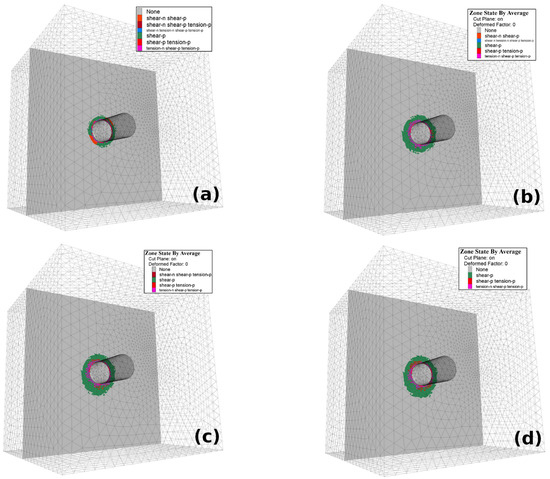
Figure 19.
Distributions of plastic zones determined using Model B assumptions in the cross-section of the rock mass model with a roadway excavation: (a) without mining influence, (b) longwall face 20 m before the excavation, (c) longwall face directly beneath the excavation, (d) longwall face 20 m beyond the excavation.
In the first simulation stage, the roadway is not subjected to mining influence, and the generated plastic zone (EDZ) in its vicinity has the shape of a ring with a thickness of approximately 1.1 m (Figure 19a).
As the face approaches, and consistent with the results presented above, the stress concentration zones increase, leading to an intensification of deformation and a growth of the plastic zone to 2 m in the roadway roof and a maximum of 2.7 m in the ribside–floor section adjacent to the approaching face (Figure 19b). In subsequent simulation stages, the extent of the plastic zone continues to grow until the longwall face passes beneath the roadway axis (Figure 19c). At this point, the plastic zone extends 2.5 m into the roof and reaches a distance of 3.6 m into the floor section of the roadway, which constitutes approximately 230% and 330% of the initial EDZ extent (without mining influence), respectively.
In further simulation stages, deformation increases and stress redistribution occur. However, the roadway is now located within the destressed zone above the mined seam, which prevents a further increase in the EDZ (Figure 19d).
Summarizing the above analysis of the simulation results, it can be concluded that the proposed method enables the support of roadway support design by determining both the support loading and the type of deformation to which the support system will be subjected due to mining operations conducted in the roadway’s vicinity.
5. Conclusions
The presented study introduces and evaluates a hybrid methodology for predicting rock mass deformations and mining-induced loads on underground excavations. The proposed approach integrates the classical Budryk–Knothe influence function model into a FLAC3D finite difference framework, allowing the application of analytically derived displacement boundary conditions instead of explicitly modeling large-scale extraction and caving processes. Based on the analyses conducted, the following conclusions can be drawn:
- Accuracy and reliability: Model B, constructed using the hybrid approach, demonstrated higher agreement with the reference Model C than the classical large-scale Model A. Statistical metrics, including Pearson’s R, Spearman’s Rho, RMSE, MAE, and R2, consistently indicate that the hybrid model accurately reproduces vertical displacements within the rock mass, capturing both the magnitude and distribution of mining-induced deformations. In contrast, Model A, while reproducing general trends, exhibits substantial deviations in absolute displacement values and a lower predictive capacity.
- Computational efficiency: The hybrid approach substantially reduces computational demand. Model B required nearly ten times fewer finite difference zones than Model A, resulting in over an order-of-magnitude shorter computation times across all tested constitutive models, including elastic, elasto-plastic, and elasto-plastic with softening. This efficiency enables rapid multi-scenario analyses, which are critical in practical engineering design and risk assessment.
- Practical applicability: The methodology allows detailed modeling of excavations impact on the rock mass and underground workings, including geometry and support systems, without the need to include large volumes of surrounding rock mass in the numerical model. It also facilitates simulation of staged longwall advance and multi-seam extraction. Stress distributions and deformation patterns obtained with the hybrid method closely match those predicted by classical models while overcoming their inherent limitations in scale and computational feasibility.
- General implications: The proposed hybrid method provides a reliable, efficient, and versatile tool for the geomechanical assessment of mining operations. Its adoption can enhance predictive accuracy, support optimization of excavation and support design, and contribute to improved safety and operational efficiency in underground mining.
In summary, the integration of analytically derived boundary conditions into finite difference simulations offers a robust compromise between computational efficiency and modeling accuracy, making it suitable for both research and practical engineering applications in rock mechanics and mining engineering.
Author Contributions
Conceptualization, R.Ś. and M.J.; methodology, R.Ś. and M.J.; software, R.Ś. and M.J.; validation, M.J.; formal analysis, R.Ś.; investigation, R.Ś. and M.J.; data curation, R.Ś. and M.J.; writing—original draft preparation, R.Ś. and M.J.; writing—review and editing, R.Ś. and M.J.; visualization, R.Ś. and M.J.; supervision, R.Ś. All authors have read and agreed to the published version of the manuscript.
Funding
This research received no external funding.
Institutional Review Board Statement
Not applicable.
Informed Consent Statement
Not applicable.
Data Availability Statement
The raw data supporting the conclusions of this article will be made available by the authors on request.
Conflicts of Interest
The authors declare no conflicts of interest.
References
- Jing, L. A Review of Techniques, Advances and Outstanding Issues in Numerical Modelling for Rock Mechanics and Rock Engineering. Int. J. Rock Mech. Min. Sci. 2003, 40, 283–353. [Google Scholar] [CrossRef]
- Yadav, A.; Behera, B.; Sahoo, S.K.; Singh, G.S.P.; Sharma, S.K. An Approach for Numerical Modeling of Gob Compaction Process in Longwall Mining. Min. Metall. Explor. 2020, 37, 631–649. [Google Scholar] [CrossRef]
- Zhang, G.; Liang, S.; Tan, Y.; Xie, F.; Chen, S.; Jia, H. Numerical Modeling for Longwall Pillar Design: A Case Study from a Typical Longwall Panel in China. J. Geophys. Eng. 2018, 15, 121–134. [Google Scholar] [CrossRef]
- Guo, H.; Ji, M.; Zhao, W. Roadway Support Design Based on In-situ Stress and Its Asymmetrical Distributions in a Coal Mine. Arch. Min. Sci. 2020, 65, 299–315. [Google Scholar] [CrossRef]
- Dequn, Y.; Xiangyang, Z.; Yungang, D.; Hang, D.U.; Weikun, Y.; Shuai, Z. Analysis of the stability of the roadway surrounding rock affected by mining in the close undermined coal seam. China Min. Mag. 2024, 33, 119–129. [Google Scholar] [CrossRef]
- Sun, Y.; Bi, R.; Chang, Q.; Taherdangkoo, R.; Zhang, J.; Sun, J.; Huang, J.; Li, G. Stability Analysis of Roadway Groups under Multi-Mining Disturbances. Appl. Sci. 2021, 11, 7953. [Google Scholar] [CrossRef]
- Coulthard, M.A.; Holt, G.E.; Potvin, Y.; Carter, J.; Dyskin, A.; Jeffrey, R. Numerical Modelling of Mining Near and Beneath Tailings Dam; Australian Centre for Geomechanics: Crawley, WA, Australia, 2008; pp. 341–354. [Google Scholar]
- Shabanimashcool, M. Numerical Modelling of the Longwall Mining and the Stress State in Svea Nord Coal Mine. Ph.D. Thesis, NTNU, Trondheim, Norway, 2012. [Google Scholar]
- Jiang, C.; Wang, L.; Tang, F.; Li, Z.; Wang, S.; Ren, B. Research on the Deformation and Failure Characteristics and Control Technology of Mining Area Rises under the Influence of Mining Stress. Minerals 2022, 12, 1242. [Google Scholar] [CrossRef]
- Le, D.T.; Bui, T.M. Numerical modelling techniques for studying longwall geotechnical problems under realistic geological structures. J. Min. Earth Sci. 2021, 62, 87–96. [Google Scholar] [CrossRef]
- Munjiza, A. The Combined Finite-Discrete Element Method; Wiley: Hoboken, NJ, USA, 2004; ISBN 978-0-470-84199-0. [Google Scholar]
- Cundall, P.A. A Computer Model for Simulating Progressive Large Scale Movements in Blocky Rock Systems. In Proceedings of the International Symposium on Rock Fracture, Nancy, France, 4–6 October 1971; International Society for Rock Mechanics (ISRM): Lisbon, Portugal, 1971; Volume 1, pp. 129–136. [Google Scholar]
- Behera, B.; Yadav, A.; Singh, G.S.P.; Sharma, S.K. Numerical Modeling Study of the Geo-Mechanical Response of Strata in Longwall Operations with Particular Reference to Indian Geo-Mining Conditions. Rock Mech. Rock Eng. 2020, 53, 1827–1856. [Google Scholar] [CrossRef]
- Alehossein, H.; Poulsen, B.A. Stress Analysis of Longwall Top Coal Caving. Int. J. Rock Mech. Min. Sci. 2010, 47, 30–41. [Google Scholar] [CrossRef]
- Kwaśniewski, M. Numerical Analysis of Strata Behavior in the Vicinity of a Longwall Panel in a Coal Seam Mined with Roof Caving. In Proceedings of the 1st International FLAC/DEM Symposium: Continuum and Distinct Element Numerical Modelling in Geo-Engineering, Minneapolis, MN, USA, 25–27 August 2008; Paper: 07–08. Itasca Consulting Group, Inc.: Minneapolis, MN, USA, 2008. ISBN 978-0-9767577-1-9. Available online: https://www.itascainternational.com/events/continuum-and-distinct-element-numerical-modeling-in-geo-engineering-2008 (accessed on 3 November 2025).
- Smolnik, G. Dem Numerical Modeling of Longwall Extraction of Coal in “Mysłowice” Colliery. In Minefill 2020–2021; CRC Press: London, UK, 2021; pp. 261–271. ISBN 978-1-003-20590-6. [Google Scholar]
- Yasitli, N.E.; Unver, B. 3D Numerical Modeling of Longwall Mining with Top-Coal Caving. Int. J. Rock Mech. Min. Sci. 2005, 42, 219–235. [Google Scholar] [CrossRef]
- Islavath, S.R.; Deb, D.; Kumar, H. Numerical Analysis of a Longwall Mining Cycle and Development of a Composite Longwall Index. Int. J. Rock Mech. Min. Sci. 2016, 89, 43–54. [Google Scholar] [CrossRef]
- Wang, J.; Jiang, J.; Li, G.; Hu, H. Exploration and Numerical Analysis of Failure Characteristic of Coal Pillar Under Great Mining Height Longwall Influence. Geotech. Geol. Eng. 2016, 34, 689–702. [Google Scholar] [CrossRef]
- Rajwa, S.; Janoszek, T.; Świątek, J.; Walentek, A.; Bałaga, D. Numerical Simulation of the Impact of Unmined Longwall Panel on the Working Stability of a Longwall Using UDEC 2D—A Case Study. Energies 2022, 15, 1803. [Google Scholar] [CrossRef]
- Wei, C.; Zhang, C.; Canbulat, I.; Huang, W. Numerical Investigation into Impacts of Major Fault on Coal Burst in Longwall Mining—A Case Study. Int. J. Rock Mech. Min. Sci. 2021, 147, 104907. [Google Scholar] [CrossRef]
- Zhang, C.; Wang, J.; Chang, W.; Wang, J. Research on Large Deformation Mechanism of Recovery Roadway under Mining Stress Conditions. Heliyon 2024, 10, e33552. [Google Scholar] [CrossRef]
- Corkum, A.G.; Board, M.P. Numerical Analysis of Longwall Mining Layout for a Wyoming Trona Mine. Int. J. Rock Mech. Min. Sci. 2016, 89, 94–108. [Google Scholar] [CrossRef]
- Gao, F.; Stead, D.; Coggan, J. Evaluation of Coal Longwall Caving Characteristics Using an Innovative UDEC Trigon Approach. Comput. Geotech. 2014, 55, 448–460. [Google Scholar] [CrossRef]
- Liu, W. Experimental and Numerical Study of Rock Stratum Movement Characteristics in Longwall Mining. Shock Vib. 2019, 2019, 5041536. [Google Scholar] [CrossRef]
- Wang, J.; Li, M.; Wang, Z.; Tang, Y.; Li, J.; Li, Z.; Wang, Z. A New Method for Improving Coal Wall Stability in Longwall Mining by Considering Support Stiffness. Bull. Eng. Geol. Environ. 2023, 82, 163. [Google Scholar] [CrossRef]
- Jendryś, M.; Hadam, A.; Ćwiękała, M. Directional Hydraulic Fracturing (DHF) of the Roof, as an Element of Rock Burst Prevention in the Light of Underground Observations and Numerical Modelling. Energies 2021, 14, 562. [Google Scholar] [CrossRef]
- Tien, V.T. Determination of the Movement and Deformation Areas of Strata When Exploiting Longwall of Seam 11 under the Open-Pit Mine at Ha Lam Coal Mine, Vietnam. IOP Conf. Ser. Earth Environ. Sci. 2022, 1049, 12009. [Google Scholar] [CrossRef]
- Białek, J.; Wesołowski, M.; Mielimąka, R.; Sikora, P. Deformations of Mining Terrain Caused by the Partial Exploitation in the Aspect of Measurements and Numerical Modeling. Sustainability 2020, 12, 5072. [Google Scholar] [CrossRef]
- Wu, P.; Liang, B.; Jin, J.; Li, G.; Wang, B.; Guo, B.; Yang, Z. Research of Roadway Deformation Induced by Mining Disturbances and the Use of Subsection Control Technology. Energy Sci. Eng. 2022, 10, 1030–1042. [Google Scholar] [CrossRef]
- Wesołowski, M. The Possibilities of Using Anisotropic Models of Rock Mass to Describe Deformations of The Mining Area Surface. Arch. Min. Sci. 2016, 61, 125–136. [Google Scholar] [CrossRef]
- Knothe, S. A profile equation for a definitely shaped subsidence through (Równanie profilu ostatecznie wykształconej niecki osiadania). Arch. Min. Sci. 1953, 1, 22–38. [Google Scholar]
- Knothe, S. Prediction of Mining Extraction Influences (Prognozowanie Wpływów Eksploatacji Górniczej); “Śląsk” Publishing House: Katowice, Poland, 1984. [Google Scholar]
- Budryk, W. Determination of the terrain horizontal deformations (Wyznaczanie wielkości poziomych odkształceń terenu). Arch. Min. Sci. 1953, 1, 63. [Google Scholar]
- Álvarez-Fernández, M.I.; González-Nicieza, C.; Menéndez-Díaz, A.; Álvarez-Vigil, A.E. Generalization of the n–k Influence Function to Predict Mining Subsidence. Eng. Geol. 2005, 80, 1–36. [Google Scholar] [CrossRef]
- Luo, Y.; Cheng, J. An Influence Function Method Based Subsidence Prediction Program for Longwall Mining Operations in Inclined Coal Seams. Min. Sci. Technol. 2009, 19, 592–598. [Google Scholar] [CrossRef]
- Ren, G.; Whittaker, B.N.; Reddish, D.J. Mining Subsidence and Displacement Prediction Using Influence Function Methods for Steep Seams. Min. Sci. Technol. 1989, 8, 235–251. [Google Scholar] [CrossRef]
- Lin, S.; Whittaker, B.N.; Reddish, D.J. Application of Asymmetrical Influence Functions for Subsidence Prediction of Gently Inclined Seam Extractions. Int. J. Rock Mech. Min. Sci. Geomech. Abstr. 1992, 29, 479–490. [Google Scholar] [CrossRef]
- Sheorey, P.R.; Loui, J.P.; Singh, K.B.; Singh, S.K. Ground Subsidence Observations and a Modified Influence Function Method for Complete Subsidence Prediction. Int. J. Rock Mech. Min. Sci. 2000, 37, 801–818. [Google Scholar] [CrossRef]
- Ścigała, R. Computer Aided Forecasting of Rock Mass and Surface Deformations (Komputerowe Wspomaganie Prognozowania Deformacji Górotworu i Powierzchni Wywołanych Podziemną Eksploatacją Górniczą); Publishing House of Silesian University of Technology: Gliwice, Poland, 2008; ISBN 978-83-7335-505-7. [Google Scholar]
- Ścigała, R. The Identification of Parameters of Theories Used for Prognoses of Post Mining Deformations by Means of Present Software. Arch. Min. Sci. 2013, 58, 1347–1357. [Google Scholar] [CrossRef]
Disclaimer/Publisher’s Note: The statements, opinions and data contained in all publications are solely those of the individual author(s) and contributor(s) and not of MDPI and/or the editor(s). MDPI and/or the editor(s) disclaim responsibility for any injury to people or property resulting from any ideas, methods, instructions or products referred to in the content. |
© 2025 by the authors. Licensee MDPI, Basel, Switzerland. This article is an open access article distributed under the terms and conditions of the Creative Commons Attribution (CC BY) license (https://creativecommons.org/licenses/by/4.0/).